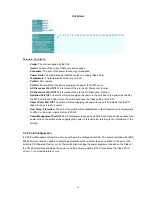
y
Default Applicant Mode:
The mode here means the type of participant. There are two modes, normal participant and
non-participant, provided for the user’s choice.
y
Normal:
It is Normal Participant. In this mode, the switch participates normally in GARP protocol exchanges.
The default setting is Normal.
y
Non-Participant:
It is Non-Participant. In this mode, the switch does not send or reply any GARP messages. It just
listens messages and reacts for the received GVRP BPDU.
y
Default Registrar Mode:
The mode here means the type of Registrar. There are three types of parameters for registrar
administrative control value, normal registrar, fixed registrar and forbidden registrar, provided for the
user’s choice.
Normal:
It is Normal Registration. The Registrar responds normally to incoming GARP messages. The
default setting is Normal.
Fixed:
It is Registration Fixed. The Registrar ignores all GARP messages, and all members remain in the
registered (IN) state.
Forbidden:
It is Registration Forbidden. The Registrar ignores all GARP messages, and all members remain in
the unregistered (EMPTY) state.
y
Restricted Mode:
This function is used to restrict dynamic VLAN be created when this port received GVRP PDU. There
are two modes, disable and enable, provided for the user’s choice.
Disabled:
In this mode, the switch dynamic VLAN will be created when this port received GVRP PDU. The
default setting is Normal.
Enabled:
In this mode, the switch does not create dynamic VLAN when this port received GVRP PDU.
Except received dynamic VLAN message of the GVRP PDU is an existed static VLAN in the switch,
this port will be added into the static VLAN members dynamically.
3.11.2 GVRP
Counter
All GVRP counters are mainly divided into Received and Transmitted two categories to let you monitor the
GVRP actions. Actually, they are GARP packets.
34
















































